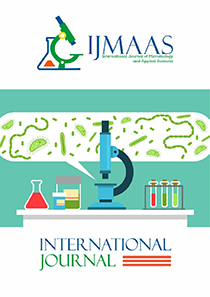Bacterial Population and Physicochemical Characteristics of Hydrocarbon Polluted Soil around Generator Houses in a Tertiary Institution in Nigeria
Vol 3, Issue 1, 2024
KEYWORDS
Electricity generators, hydrocarbon polluted soil, Bacteria, physiochemical characteristics.
Abstract
Heavy-duty generators constitute a form of hydrocarbon pollution but enrich microorganisms to having the ability to breakdown hydrocarbons hence can be used for remediation. Bacterial population and physicochemical characteristics of hydrocarbon polluted soil around generator houses in a Tertiary Institution in Nigeria was studied. Soil samples were collected from six different generator houses and control. Analysis for bacterial population and physicochemical characteristics were done using standard methods. Total heterotrophic bacterial (THB) counts ranged from 1.60 ± 0.37 × 106 cfu/g to 3.32 ± 1.36 × 106cfu/g. Hydrocarbon utilizing bacteria (HUB) counts ranged from 0.00±0.00 x104 cfu/g to 2.75 ± 0.92 × 104 cfu/g. The percentage occurrence of bacterial isolates ranges as follows; Bacillus sp. 21%, Pseudomonas sp. 18%, Staphylococcus sp. 14%, Enterobacter sp. 13%, Escharichia coli 9%, Chromobacterium sp. 8%, Corynebacterium sp. 7%, Micrococcus sp. 6%, and Vibro sp. 4%. Sequence analysis revealed the presence of Pseudomonas aeruginosa, Staphylococcus saprophyticus, Bacillus megaterium, Chromobacterium violaceum and Micrococcus luteus. Range of physiochemical characteristics of the different soil samples analysed were: pH 6.49 to 6.84, Moisture contents ranged from 6.22 to 14.70 %, Nitrate 69.05 to 2.88mg/kg, Sulphate 1.73 to 3.48mg/kg, Phoshorus 7.03 to 50.54mg/kg, Potassium 0.003 to 357.90mg/kg), Total organic carbon (TOC) 1.05 to 2.89% and Total petroleum hydrocarbon (TPH) 0.00 to 31.445mg/kg . This study revealed presence of reasonable population of indigenous hydrocarbon utilizing bacteria which can be monitored and enhanced to improve their bioremediation abilities. Finally, the study revealed that the waste hydrocarbon oil spilled within the generator houses in the institution are at minimum but also required clean-up process to remove total petroleum hydrocarbon in the soil.
Current: Vol. 4, Issue 1, 2025

Call for papers
The International Journal of Microbiology and Applied Sciences warmly welcome your valuable articles for publication.
